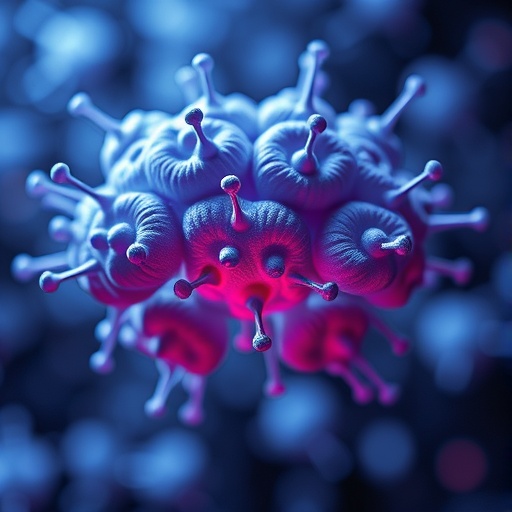In recent years, the pursuit of innovative treatments for neuropsychiatric disorders has accelerated, driven by the urgent need to overcome the limitations of existing therapeutic strategies. Among these disorders, schizophrenia—a complex condition often linked to NMDA receptor hypofunction—poses significant challenges for drug development. A groundbreaking study published in Nature in 2025 by Oosterlaken et al. heralds a new frontier in neurotherapeutics, demonstrating the superiority of nanobody-based treatments over traditional antibody formats in reversing behavioral deficits associated with NMDA receptor dysfunction.
Central to this paradigm shift is the modulation of metabotropic glutamate receptor 2 (mGlu2), a key player in synaptic neurotransmission implicated in the pathophysiology of schizophrenia. While positive allosteric modulators (PAMs) targeting mGlu2 have shown promise in vitro, their translation into effective in vivo therapies has been fraught with hurdles. Nanobodies—single-domain antibody fragments derived from camelid heavy-chain antibodies—have emerged as potent and highly specific biological tools, capable of penetrating the central nervous system and modulating receptor activity with unmatched precision.
The authors engineered two molecular constructs to probe the therapeutic potential of mGlu2-targeting agents: DN13–DN1, a dual nanobody fusion, and DN13–Fc, a fusion combining two DN13 nanobodies with a human IgG1 Fc domain, yielding an 80 kDa IgG-like protein. Although both constructs demonstrated PAM activity on mouse mGlu2 receptors in vitro, their behavioral efficacies diverged dramatically in vivo, highlighting fundamental differences in pharmacokinetics, brain penetration, and receptor engagement.
Specifically, acute intraperitoneal administration of DN13–DN1 at 10 mg/kg delivered robust and reproducible behavioral improvements across two distinct mouse models of schizophrenia. The neurodevelopmental phencyclidine (PCP) model and the genetic GluN1 knockdown (GluN1-KD) model both exhibited marked restoration of cognitive functions, including working memory and sensorimotor gating deficits, which recapitulate key aspects of human disease. These results underscore the nanobody’s ability to rectify NMDA receptor hypofunction-associated impairments, affirming its therapeutic potential.
Conversely, administration of the DN13–Fc IgG-like construct failed to elicit any measurable behavioral enhancements at an equivalent dosage, despite confirmed receptor binding and PAM activity. This stark contrast suggests that the nanobody format affords superior brain bioavailability and functional receptor modulation, likely due to its smaller size and enhanced penetration across the blood–brain barrier (BBB), critical factors limiting conventional antibodies in central nervous system drug delivery.
Further behavioral analyses revealed that DN13–DN1—but not DN13–Fc—significantly attenuated hyperlocomotion observed in GluN1-KD mice, a phenotype aligned with schizophrenic hyperactivity. Importantly, these findings were consistent regardless of animal sex, indicating broad applicability and minimizing concerns of sex-specific pharmacodynamics. Moreover, no off-target or adverse effects on motor coordination, balance, or cataleptic behavior were observed following nanobody treatment, attesting to its safety profile in preclinical models.
Given that nanobodies are produced in bacterial systems, which can introduce endotoxin contaminants such as lipopolysaccharide (LPS), the study robustly investigated the impact of potential endotoxin-induced confounds. Through rigorous purification steps reducing endotoxin levels from 24.15 ± 7.55 μg/mg to 0.19 ± 0.18 μg/mg DN13–DN1, the authors demonstrated that behavioral improvements remained unaffected. This critical control effectively excluded endotoxin contamination as a factor in the therapeutic outcomes, reinforcing the pharmacological validity of the nanobody’s effects.
Mechanistically, the study posits that nanobody-mediated PAM activity potentiates endogenous glutamate signaling via mGlu2 receptors, thereby compensating for NMDA receptor hypofunction—a hallmark of schizophrenia pathophysiology. By selectively stabilizing receptor conformations conducive to enhanced signaling, DN13–DN1 restores synaptic balance and cognitive processing disrupted in disease states. This nuanced receptor modulation contrasts with traditional small molecule approaches that often suffer from limited selectivity and tolerability.
The implications of these findings extend beyond schizophrenia, opening avenues for nanobody therapeutics targeting a spectrum of central nervous system disorders characterized by receptor dysregulation. Their modular design, manageable size, and amenability to bacterial production position nanobodies as versatile scaffolds for next-generation biologics with improved brain targeting capabilities. Additionally, the avoidance of Fc-mediated immune effector functions potentially reduces the risk of adverse inflammatory responses often seen with full-length antibodies.
This study’s comprehensive multi-model behavioral assessment framework exemplifies the rigorous preclinical validation needed to propel nanobodies toward clinical translation. By integrating cognitive assays such as novel object recognition (NOR), Y-maze working memory tests, spontaneous alternation, and prepulse inhibition (PPI) of startle reflex, the research delineates a robust phenotype rescue profile. The robustness of these effects across genetic and pharmacological models strengthens the translational relevance to human schizophrenia.
Moreover, the work underscores an emerging principle in neuropharmacology: molecular format and size critically influence therapeutic efficacy in the brain. The contrast between DN13–DN1 and DN13–Fc delineates how nanobody architecture enhances receptor accessibility and functional modulation. These insights provide a framework to optimize antibody-based brain therapeutics, prompting reevaluation of the dominance of traditional IgG formats in neuropsychiatric drug discovery.
Importantly, the safety profile characterized in murine models is promising, but future studies are warranted to further assess long-term effects, immunogenicity, and dosing regimens in larger mammals and ultimately humans. The scalability of bacterial expression combined with purification advances suggests feasibility for clinical-grade production, positioning DN13–DN1 and similar nanobody constructs as viable candidates for therapeutic development.
In summary, Oosterlaken et al. illuminate a transformative therapeutic strategy leveraging nanobody technology to overcome the longstanding challenges of targeting brain mGlu2 receptors in disorders associated with NMDA receptor deficits. The ability to rescue complex behavioral phenotypes in multiple complementary mouse models not only validates the approach but also lays a solid foundation for nanobody therapeutics in neuropsychiatric medicine. As the field gravitates towards precision biologics, these findings herald a significant step toward effective, brain-penetrant, antibody-derived therapies capable of addressing unmet clinical needs in schizophrenia and beyond.
Subject of Research:
Nanobody-mediated modulation of mGlu2 receptors to rescue behavioral deficits related to NMDA receptor hypofunction in mouse models of schizophrenia.
Article Title:
Nanobody therapy rescues behavioural deficits of NMDA receptor hypofunction.
Article References:
Oosterlaken, M., Rogliardo, A., Lipina, T. et al. Nanobody therapy rescues behavioural deficits of NMDA receptor hypofunction. Nature (2025). https://doi.org/10.1038/s41586-025-09265-8
Image Credits:
AI Generated




